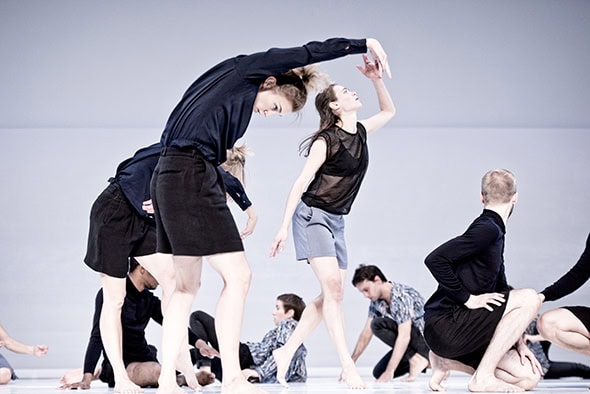Cullberg Ballet in Deborah Hay’s Figure A Sea at Southbank Centre
Posted: September 9th, 2019 | Author: Caterina Albano | Filed under: Performance | Tags: Caspar David Friedrich, Cullberg Ballet, Deborah Hay, Figure a Sea, Marita Tiämström, Michel Serres, Mimma Tiikkainen | Comments Off on Cullberg Ballet in Deborah Hay’s Figure A Sea at Southbank CentreCullberg Ballet, Figure a Sea, Queen Elizabeth Hall, Southbank Centre, September 6

In Caspar David Friedrich’s painting, The Monk by the Sea (1809), a diminutive figure stands on a seashore facing the horizon. The viewer observes the observer at a distance, removed from the scene and at the same time vicariously present in it. Such an image resonates with Deborah Hay’s Figure a Sea (2015), choreographed for Cullberg Ballet — where Hay is one of three associate artists — who perform it at Southbank Centre’s Queen Elizabeth Hall on a welcome visit to London.
The bare stage is defined only by lighting designer Mimma Tiikkainen’s white rectangle of light and a white backdrop. Divided in three groups in Marita Tiämström’s costumes, Cullberg Ballet’s seventeen dancers respond to some unspoken tasks by exploring the emergence and dissipation of movement either in isolation or in couples and trios. They sit or stand still, with only the slightest tilt of the head; they embrace each other then move apart; they walk each in their own specific and singular way of lifting one foot in front of the other and putting it back down, or creating a dance sequence that another dancer reciprocates through her own variations, their hands at times held in front of them like imaginary mirrors. They freeze a posture as if posing for a long-exposure photograph, or seamlessly continue the trajectory started by the kinetic energy of a movement till fully exhausted as they follow the rhythm of their own murmuring voices or that of the changing cadences and vibrations of Laurie Anderson’s soundtrack that in turn emerges and dissipates like waves. The effect is of a kaleidoscope of varying patterns, forms and images that shift across the stage or happen at either side, each distinctive but also expansively related to each other.
Hay describes Figure a Sea as ‘a meditation on seeing. Seeing music, fleeting incidences and synchronicities, unbelievable unexpectedness and, most surprising – seeing the unnameable. It is a space for seeing oneself seeing’. In meditation, to see oneself seeing suggests the immersive experience of feeling movement, touch and hearing, of ‘seeing’ what the sensations and emotions of incidences feel like without lingering on possible narratives or meanings. Hence, ‘synchronicities’, ‘unbelievable unexpectedness’ and even ‘the unnameable’ are characterised by the uniqueness of the observer’s experiencing and feeling as a state in which one is both the subject and object of the observation. Quantum physics underlines the importance of such a point of view, positing that an event is intrinsically determined by the observer, since any observation is the result of a subjective response and the observer partakes of the very unfolding of experience. By offering us a meditation on seeing, Hay thus makes us the removed participant of its very articulation. She takes us to the core of what French scholar Michel Serres refers to as ‘the knot of the sensible’, where all the senses converge in the very act of seeing that Serres understands in terms of movement; this is the way Hay asks us to see, to observe, to be present. What we see and what we feel depends on our willingness to enter the realm of the sensible and to figure what sea of possibilities can fill an empty white space, to see the emergence of motion in stillness and stillness in the endless flux of movement that makes space and time.
Figure a Sea ends with the dancers leaving the stage one by one, until only one remains; as the lights gradually dim, she also leaves. The white rectangle seems to flicker like the surface of the sea and a shadow divides the backdrop in half. It is as if Friedrich’s painting has been projected back to the audience, and now we are the figure looking out into infinity.